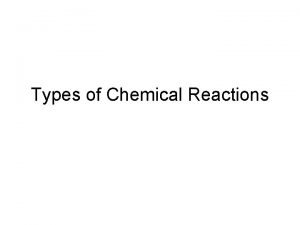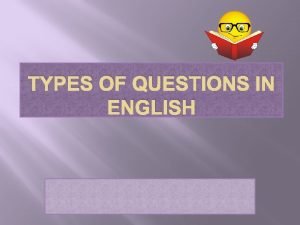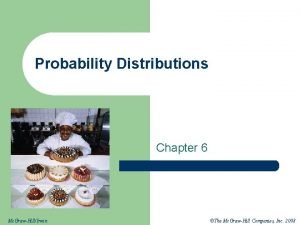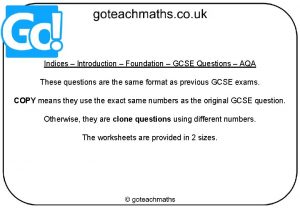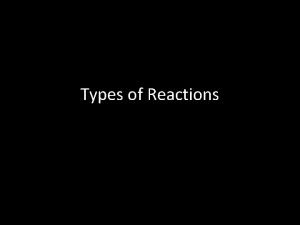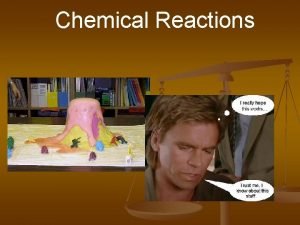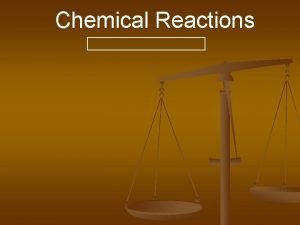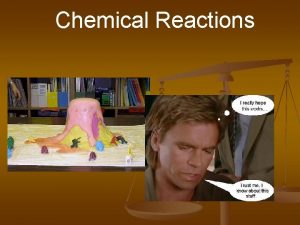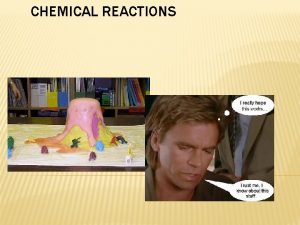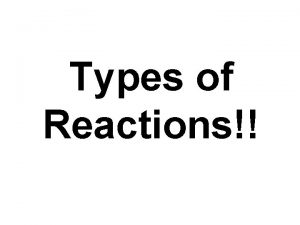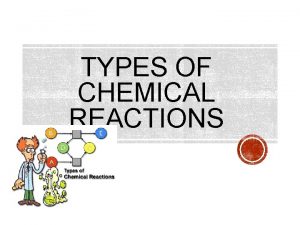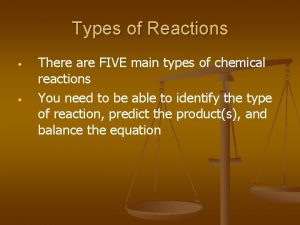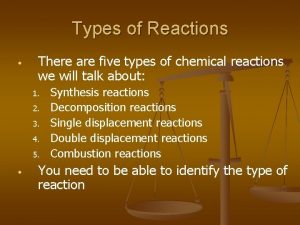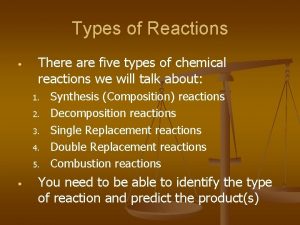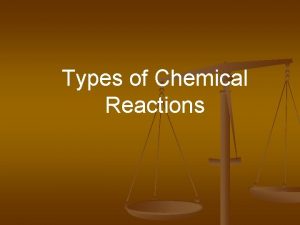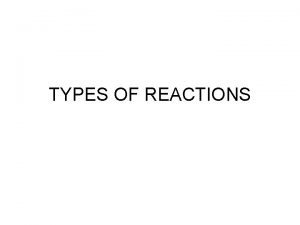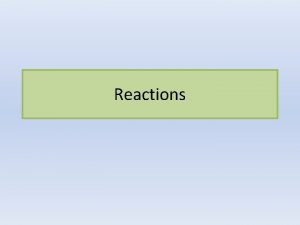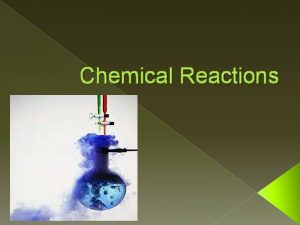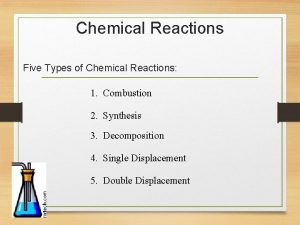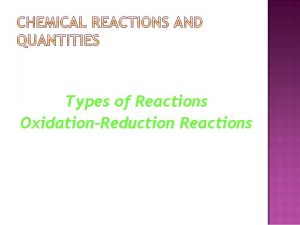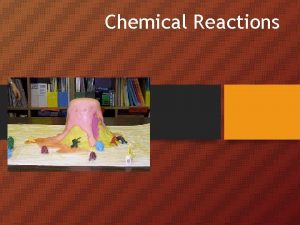Types of Reactions There are five types of























- Slides: 23

Types of Reactions • There are five types of chemical reactions we will talk about: 1. 2. 3. 4. 5. • Synthesis reactions _______ reactions Single displacement reactions ________ reactions Combustion reactions You need to be able to identify the type of reaction and predict the product(s)

• Steps to Writing Reactions Some steps for doing reactions 1. 2. 3. Identify the type of reaction Predict the product(s) using the type of reaction as a model Balance it Don’t forget about the diatomic elements! (Br. INCl. HOF) For example, Oxygen is O 2 as an element. In a compound, it can’t be a diatomic element because it’s not an element anymore, it’s a compound!

1. Synthesis reactions • Synthesis reactions occur when two substances (generally elements) combine and form a compound. (Sometimes these are called combination or addition reactions. ) reactant + reactant 1 product • Basically: A + B AB • Example: 2 H 2 + O 2 2 H 2 O • Example: C + O 2 CO 2

Synthesis Reactions • Here is another example of a synthesis reaction

Practice • Predict the products. Write and balance the following synthesis reaction equations. • Sodium metal reacts with chlorine gas Na(s) + Cl 2(g) • Solid Magnesium reacts with fluorine gas Mg(s) + F 2(g) • Aluminum metal reacts with fluorine gas Al(s) + F 2(g)

2. Decomposition Reactions • Decomposition reactions occur when a compound breaks up into the elements or in a few to simpler compounds • 1 Reactant Product + Product • In general: AB A + B • Example: 2 H 2 O 2 H 2 + O 2 • Example: 2 Hg. O 2 Hg + O 2

Decomposition Reactions • Another view of a decomposition reaction:

Decomposition Exceptions • Carbonates and chlorates are special case decomposition reactions that do not go to the elements. • Carbonates (CO 32 -) decompose to carbon dioxide and a metal oxide • Example: Ca. CO 3 CO 2 + Ca. O • Chlorates (Cl. O 3 -) decompose to oxygen gas and a metal chloride • Example: 2 Al(Cl. O 3)3 2 Al. Cl 3 + 9 O 2 • There are other special cases, but we will not explore those in Chemistry I

Practice • Predict the products. Then, write and balance the following decomposition reaction equations: • Solid Lead (IV) oxide decomposes Pb. O 2(s) • Aluminum nitride decomposes Al. N(s)

Practice Identify the type of reaction for each of the following synthesis or decomposition reactions, and write the balanced equation: H 2(g) + O 2(g) Ba. CO 3(s) Li(s)+ S(s) NH 3(g) + H 2 CO 3(aq) NI 3(s)

3. Single Replacement Reactions • Single Replacement Reactions occur when one element replaces another in a compound. • A metal can replace a metal (+) OR a nonmetal can replace a nonmetal (-). • element + compound A + BC AC + B (if A is a metal) OR A + BC BA + C (if A is a nonmetal) (remember the cation always goes first!) When H 2 O splits into ions, it splits into H+ and OH- (not H+ and O-2 !!)

Single Replacement Reactions • Another view:

Single Replacement Reactions • Write and balance the following single replacement reaction equation: • Zinc metal reacts with aqueous hydrochloric acid Zn(s) + 2 HCl(aq) Zn. Cl 2 + H 2(g) Note: Zinc replaces the hydrogen ion in the reaction

Single Replacement Reactions • Sodium chloride solid reacts with fluorine gas 2 Na. Cl(s) + F 2(g) 2 Na. F(s) + Cl 2(g) Note that fluorine replaces chlorine in the compound • Aluminum metal reacts with aqueous copper (II) nitrate Al(s)+ Cu(NO 3)2(aq)

4. Double Replacement Reactions • Double Replacement Reactions occur when a metal replaces a metal in a compound a nonmetal replaces a nonmetal in a compound • Compound + compound+ compound • AB + CD AD + CB

Double Replacement Reactions • First and last ions go together + inside ions go together • Example: Ag. NO 3(aq) + Na. Cl(s) Ag. Cl(s) + Na. NO 3(aq) • Another example: K 2 SO 4(aq) + Ba(NO 3)2(aq) 2 KNO 3(aq) + Ba. SO 4(s)

• 1. 2. 3. 4. 5. 6. Practice Predict the products. Balance the equation HCl(aq) + Ag. NO 3(aq) Ca. Cl 2(aq) + Na 3 PO 4(aq) Pb(NO 3)2(aq) + Ba. Cl 2(aq) Fe. Cl 3(aq) + Na. OH(aq) H 2 SO 4(aq) + Na. OH(aq) KOH(aq) + Cu. SO 4(aq)

5. Combustion Reactions • Combustion reactions occur when a hydrocarbon reacts with oxygen gas. • This is also called burning!!! In order to burn something you need the 3 things in the “fire triangle”: 1) A Fuel (hydrocarbon) 2) Oxygen to burn it with 3) Something to ignite the reaction (spark)

Combustion Reactions • In general: Cx. Hy + O 2 CO 2 + H 2 O • Products in combustion are ALWAYS carbon dioxide and water. (although incomplete burning does cause some byproducts like carbon monoxide) • Combustion is used to heat homes and run automobiles (octane, as in gasoline, is C 8 H 18)

Combustion Reactions Edgar Allen Poe’s drooping eyes and mouth are potential signs of CO poisoning.

Combustion • Example • C 5 H 12 + 8 O 2 5 CO 2 +6 H 2 O • Write the products and balance the following combustion reaction: • C 10 H 22 + O 2

Mixed Practice • 1. 2. 3. 4. 5. State the type, predict the products, and balance the following reactions: Ba. Cl 2 + H 2 SO 4 C 6 H 12 + O 2 Zn + Cu. SO 4 Cs + Br 2 Fe. CO 3

Net Ionic Equations �Try this one! �Silver nitrate reacts with Lead (II) Chloride in hot water. Molecular:
 Antigentest åre
Antigentest åre Combustion chemical reaction
Combustion chemical reaction 5 types of reactions
5 types of reactions Section 2 classifying chemical reactions
Section 2 classifying chemical reactions How to write a balanced redox reaction
How to write a balanced redox reaction Chemical reactions section 2 classifying chemical reactions
Chemical reactions section 2 classifying chemical reactions Types of reactions
Types of reactions Unit 5 chemical reactions answers
Unit 5 chemical reactions answers Types of questions in english
Types of questions in english The sounding cataract haunted me
The sounding cataract haunted me One in five challenge
One in five challenge Five elements and five senses
Five elements and five senses Macbeth seyton i am sick at heart
Macbeth seyton i am sick at heart All the beds were
All the beds were There are five flights daily from pittsburgh
There are five flights daily from pittsburgh Gcse
Gcse Types of chemical reactions redox
Types of chemical reactions redox How to identify types of chemical reactions
How to identify types of chemical reactions Different types of reactions
Different types of reactions Types of reactions chemistry
Types of reactions chemistry What are the 5 types of chemical reactions
What are the 5 types of chemical reactions 4 types of chemical reactions
4 types of chemical reactions Nuclear fission equation
Nuclear fission equation Four types of chemical reactions
Four types of chemical reactions

